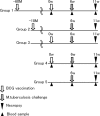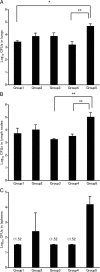Influence of advanced age on Mycobacterium bovis BCG vaccination in guinea pigs aerogenically infected with Mycobacterium tuberculosis
- PMID: 20685935
- PMCID: PMC2953003
- DOI: 10.1128/CVI.00190-10
Influence of advanced age on Mycobacterium bovis BCG vaccination in guinea pigs aerogenically infected with Mycobacterium tuberculosis
Abstract
Mycobacterium bovis bacillus Calmette-Guérin (BCG) is the only tuberculosis (TB) vaccine currently available, but its efficacy against adult pulmonary TB remains controversial. BCG induces specific immune responses to mycobacterial antigens and may elicit protective immunity against TB. TB remains a major public health problem, especially among the elderly, yet the efficacy of BCG in the elderly is unknown. We investigated the ability of BCG vaccination to prevent TB in young (6-week-old), middle-aged (18-month-old), and old (60-month-old) guinea pigs. BCG-Tokyo vaccination reduced the growth of Mycobacterium tuberculosis H37Rv in all three groups. By use of an enzyme-linked immunospot (ELISPOT) assay, antigen-specific gamma interferon (IFN-γ)-producing cells were detected in the 60-month-old guinea pigs after a booster vaccination with BCG-Tokyo. Our findings suggest that BCG-Tokyo has a protective effect against tuberculosis infection regardless of age.
Figures






Similar articles
-
Aerosol immunization by alginate coated mycobacterium (BCG/MIP) particles provide enhanced immune response and protective efficacy than aerosol of plain mycobacterium against M.tb. H37Rv infection in mice.BMC Infect Dis. 2019 Jul 1;19(1):568. doi: 10.1186/s12879-019-4157-2. BMC Infect Dis. 2019. PMID: 31262260 Free PMC article.
-
A booster vaccine expressing a latency-associated antigen augments BCG induced immunity and confers enhanced protection against tuberculosis.PLoS One. 2011;6(8):e23360. doi: 10.1371/journal.pone.0023360. Epub 2011 Aug 17. PLoS One. 2011. PMID: 21858087 Free PMC article.
-
Recombinant bacille Calmette-Guerin coexpressing Ag85b, CFP10, and interleukin-12 elicits effective protection against Mycobacterium tuberculosis.J Microbiol Immunol Infect. 2017 Feb;50(1):90-96. doi: 10.1016/j.jmii.2014.11.019. Epub 2014 Dec 11. J Microbiol Immunol Infect. 2017. PMID: 25732698
-
[Novel vaccines against M. tuberculosis].Kekkaku. 2006 Dec;81(12):745-51. Kekkaku. 2006. PMID: 17240920 Review. Japanese.
-
Clinical Testing of Tuberculosis Vaccine Candidates.Microbiol Spectr. 2016 Oct;4(5). doi: 10.1128/microbiolspec.TBTB2-0015-2016. Microbiol Spectr. 2016. PMID: 28087924 Review.
Cited by
-
Tuberculosis in an Aging World.Pathogens. 2022 Sep 26;11(10):1101. doi: 10.3390/pathogens11101101. Pathogens. 2022. PMID: 36297158 Free PMC article. Review.
-
A prospective cross-sectional study of tuberculosis in elderly Hispanics reveals that BCG vaccination at birth is protective whereas diabetes is not a risk factor.PLoS One. 2021 Jul 29;16(7):e0255194. doi: 10.1371/journal.pone.0255194. eCollection 2021. PLoS One. 2021. PMID: 34324578 Free PMC article.
-
BCG as a game-changer to prevent the infection and severity of COVID-19 pandemic?Allergol Immunopathol (Madr). 2020 Sep-Oct;48(5):507-517. doi: 10.1016/j.aller.2020.05.002. Epub 2020 Jul 3. Allergol Immunopathol (Madr). 2020. PMID: 32653224 Free PMC article. Review.
-
Attrition of T-cell functions and simultaneous upregulation of inhibitory markers correspond with the waning of BCG-induced protection against tuberculosis in mice.PLoS One. 2014 Nov 24;9(11):e113951. doi: 10.1371/journal.pone.0113951. eCollection 2014. PLoS One. 2014. PMID: 25419982 Free PMC article.
References
-
- Aktas, E., F. Ciftci, S. Bilgic, O. Sezer, E. Bozkanat, O. Deniz, U. Citici, and G. Deniz. 2009. Peripheral immune response in pulmonary tuberculosis. Scand. J. Immunol. 70:300-308. - PubMed
-
- Andersen, P. 2007. Tuberculosis vaccines—an update. Nat. Rev. Microbiol. 5:484-487. - PubMed
-
- Aronson, N. E., M. Santosham, G. W. Comstock, R. S. Howard, L. H. Moulton, E. R. Rhoades, and L. H. Harrison. 2004. Long-term efficacy of BCG vaccine in American Indians and Alaska Natives: a 60-year follow-up study. JAMA 291:2086-2091. - PubMed
-
- Babu, S., S. Q. Bhat, N. P. Kumar, S. Jayantasri, S. Rukmani, P. Kumaran, P. G. Gopi, C. Kolappan, V. Kumaraswami, and T. B. Nutman. 2009. Human type 1 and 17 responses in latent tuberculosis are modulated by coincident filarial infection through cytotoxic T lymphocyte antigen-4 and programmed death-1. J. Infect. Dis. 200:288-298. - PMC - PubMed
-
- Barreto, M. L., S. M. Pereira, and A. A. Ferreira. 2006. BCG vaccine: efficacy and indications for vaccination and revaccination. J. Pediatr. (Rio J.) 82:S45-S54. - PubMed
MeSH terms
Substances
LinkOut - more resources
Full Text Sources
Medical

